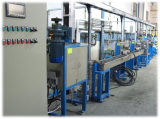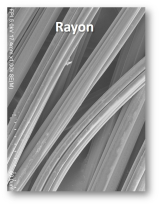Rheology of CNF (Cellulose NanoFibrils)
Leila Jowkarderis and Theo van de Ven
 Cellulose nanofibrils (CNF) are long and thin rodlike particles, produced by disintegration of wood fiber. Each nanofibril consists of a number of aligned cellulose molecules bundled together by hydrogen bonds. Increasing environmental concerns have led to efforts to replace petroleum based products with materials from biodegradable and renewable sources, such as cellulose. Owing to their high aspect ratio (length/diameter>100) and high degree of crystallinity (~80), cellulose nanofibrils in water make viscous suspensions and stiff gels, promising for many industrial applications. For example, CNF has been suggested as rheology modifier in food, paint, cosmetics, and pharmaceutical products. Therefore, knowledge of viscoelastic properties of CNF suspensions is important. In this project, we study the rheology of CNF hydrogels in a wide concentration range, and investigate the effects of ionic strength, polyelectrolyte, and chemical crosslinking on the viscoelastic properties of these suspensions
Cellulose nanofibrils (CNF) are long and thin rodlike particles, produced by disintegration of wood fiber. Each nanofibril consists of a number of aligned cellulose molecules bundled together by hydrogen bonds. Increasing environmental concerns have led to efforts to replace petroleum based products with materials from biodegradable and renewable sources, such as cellulose. Owing to their high aspect ratio (length/diameter>100) and high degree of crystallinity (~80), cellulose nanofibrils in water make viscous suspensions and stiff gels, promising for many industrial applications. For example, CNF has been suggested as rheology modifier in food, paint, cosmetics, and pharmaceutical products. Therefore, knowledge of viscoelastic properties of CNF suspensions is important. In this project, we study the rheology of CNF hydrogels in a wide concentration range, and investigate the effects of ionic strength, polyelectrolyte, and chemical crosslinking on the viscoelastic properties of these suspensions
Superabsorbent fibers and their structures
Goeun Sim, Louis Godbout, Md Nur Alam and Theo van de Ven


Heterogeneous swelling of the fibers, which generates balloon-like structures, was reported during fiber dissolution, carboxylation, and high pressure homogenization. The fact that ballooning is a ubiquitous phenomenon in cellulose fiber treatments indicates that this structural change is mainly related to the cellulose microfibril arrangements in fiber walls, specifically in secondary layers. The low accessibility, therefore the low reactivity issues in cellulose derivatization could be closely related to the non-uniform swelling of the fiber structure.
We study the swelling behaviors of cellulose wood fibers upon applying various mechanical and chemical treatments.
Novel textile fibers
Md Nur Alam, Theo van de Ven
Alois Vanarek, Zohreh Sabzalian from FPInnovations
We have developed an environmentally-friendly process to produce textile fibers Trials on a pilot spinneret showed that textile fibers can be produced at industrial speeds and drawing rates. The resulting fibers have a degree of substitution ranging from 0.1 – 0.4 which greatly improves the hydrophilic behavior of the produced textile. As a result, the water absorbency of this textile is high, which limits its use to one-time applications. To extend the range of applications, the fibers can be post-treated by modifying the functional carboxyl groups into hydrophobic groups. We also focus on conditions that affect the hydrophobicity of our yarn in order to obtain absorption properties similar to those of cotton fabric which has a water uptake of about 1.5 g/g yarn.



Cellulose wound dressing
Mandana Tavakolian, Theo van de Ven
We plan to develop bioactive surfaces to be used as wound dressings. Such surfaces should ideally be capable of deactivating targeted harmful microorganisms. The base material for synthesizing such surfaces was chosen to be wood-based cellulose fibers. In addition, the antimicrobial agent was chosen from natural antimicrobial agents. So, the overall goal of this project is to develop a green antimicrobial wound dressing.